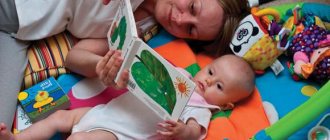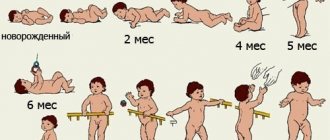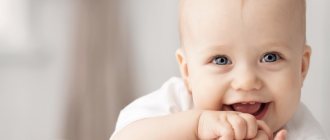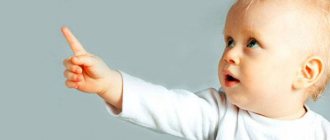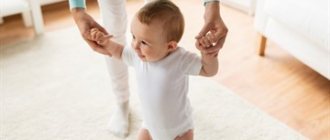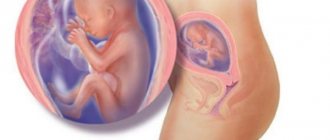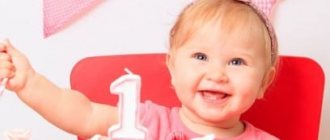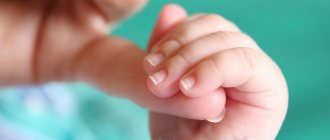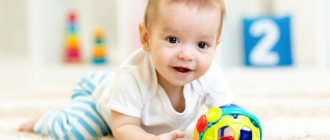Physical development
During the second month, the child should gain one-fourth of his weight at the end of the first month, that is, 800 grams (plus or minus 100-200 grams). During this period, the baby's height will increase by one tenth, that is, by 3-4 centimeters. Is it possible to imagine such growth rates in humans?!
Imagine that in November you will be 10% taller than in October?! And in December you will gain 25% of your November body weight?! It sounds fabulously like this: “not by the day, but by the hour,” but is scientifically formulated as follows: “In no period of its development does the human body grow at such a speed as in the first months of life.” The baby’s chest circumference increases by 15–20 mm in the second month, the head circumference increases on average the same, and the baby’s brain should gain 40–50 grams during this period. All internal systems and organs of the baby are actively developing.
Baby's nutrition at 3 months
The ideal product for feeding a three-month-old baby is breast milk. Generally speaking, it is recommended to continue breastfeeding for as long as possible, at least 6 months, and preferably a year.
Introducing complementary foods at 3 months to a child with normal development is too early! This is confirmed by the following factors:
- the baby’s body is not yet ready to accept new food; it can cause mechanical and chemical damage to the gastrointestinal tract;
- the baby’s reflex to push out what gets into the mouth with the tongue has not yet disappeared;
- the baby is not able to sit or fully hold his head upright;
- The baby's immunity is not yet fully developed, any product can cause severe allergies.
If your baby lacks nutrients for one reason or another, or is underweight, try supplemental feeding. This is a method in which adapted milk formulas are given along with breast milk. The amount of supplementary feeding is calculated by subtracting the amount of milk received from the required amount.
Complementary feeding at this age can only be introduced on the recommendation of a pediatrician. Usually premature babies or those who are severely underweight begin to be fed this early.
So, if the baby still needs complementary feeding: where to start, how to introduce it?
3 month old baby rules for introducing complementary foods
The baby will have to be held in your arms. Anyone, not just a premature baby at 3 months, does not sit, development, the list of what should be able to normally do not include this. Make sure that the child does not throw back his head. In general, they are fed only with a spoon. But some pediatricians advise such young children to drip food into their mouths using a pipette or pacifier (do not let them suck, but drip on their own!).
First of all, we must remember that complementary foods are given after breast milk (or formula), otherwise the baby will refuse it. They always start with one product, giving it literally half a teaspoon. Today it is advised to start early complementary feeding with cereals, but always gluten-free! You can cook them with water, breast milk or formula, but in no case with cow's milk. Casein, a protein in cow's milk, has an 80% chance of causing an allergy. The temperature of the product should be approximately the same as breast milk. It is worth buying special cereals for baby food. Rice, buckwheat, and oatmeal porridge are suitable, but have a very liquid consistency.
Another option for early complementary feeding is homogeneous vegetable purees. It is best to start with them if the baby is premature; they perfectly compensate for the lack of microelements. Puree made from zucchini, broccoli, cauliflower, and pumpkin works well. It is possible to introduce carrot puree. Read the packaging carefully: there should be no foreign products in the puree, only vegetables and water. For older children, the presence of a natural thickener is not a critical factor. However, for three-month-old babies, liquid puree is an ideal option.
It is acceptable to introduce egg yolk, but in very, very small volumes so that the baby can swallow it. A good method is to mix the yolk with milk (especially if we are talking about “artificial” milk).
Feeding fruit purees and juices is a very delicate issue. Even for healthy children, they are not introduced immediately. This issue should be resolved with a pediatrician. If the doctor does not prohibit the introduction of fruits, then after vegetable purees and cereals you can try this. The introduction of exotic fruits is unacceptable. You can offer your baby puree from green apples and pears. If the baby is bottle-fed, then constipation becomes a common problem. In this case, it is recommended to feed with plums and prunes.
Remember that complementary feeding always starts with one product. You can’t introduce several at once; it’s important to see the baby’s reaction to each one. A new element should appear only when the child’s body has become accustomed to the previous one, and you are sure that an allergic reaction does not develop.
Thus, if for medical reasons it is necessary to diversify a child’s diet at 3 months and introduce complementary foods, the menu may be as follows:
- 6.00: breast milk or formula (mixed feeding possible).
- 9.30: egg yolk (up to 30g) or porridge, 20 ml of vegetable or fruit juice, milk.
- 13.00: vegetable puree (30 g), milk.
- 16.00: fruit or vegetable juice (30 ml), milk.
- 20.00: porridge or vegetable puree, milk.
Feeding the baby “on demand” can only be done while breastfeeding. In any case, if he asks to eat at night, complementary foods are not given.
If your baby has constipation, be sure to read this article.
What motor skills are typical?
The baby raises his head well and holds it in an upright position for several tens of seconds. When the baby lies on his stomach, he raises his head and chest and holds them in this position for some time. The baby's arms and legs are relaxed, they stretch to the sides. The child may shake his head if someone supports him in a sitting position. Involuntary muscle twitching occurs less frequently than in the first month. The baby is able to hold a rattle or other object for a short time, tightly grasping it with his palm. His fists are partially open, and sometimes he can flail his arms aimlessly.
A few words about baby's skin
The skin is both a protective barrier against a huge number of aggressive environmental influences on the human body, and an important sensor that perceives various external signals, and an effective thermostat. His health and well-being largely depend on the condition of a child’s skin. The skin of infants has a number of age-related characteristics that do not allow it to fully resist injuries and infections. That is why mom and dad need to pay special attention to proper care of the baby’s skin.
Educational games and exercises with a 3-month-old baby
Just physically caring for a baby is not enough, no matter how small and unintelligent it may seem. At 3 months old, you should talk to your child and study as much as possible, sing to him and tell him rhymes, in general, develop him.
Did you know? From century to century, from mouth to mouth, from mother to daughter, various primitive games have been carefully passed down, which are of enormous importance for the development and functioning of nervous and physical activity: short rhythmic poems on everyday topics, recited and repeated many times, finger games, etc. .
In addition, adults and older children intuitively use exaggerated facial expressions and try to imitate the baby’s speech, which contributes to faster and better understanding and assimilation of the material.
Games
You should talk to the baby from his first days, and even before birth, accustoming him to his voice and its intonations. After birth, in those moments when the child is awake and during hygiene procedures, changing clothes and other actions, you need to voice what you are doing, name objects, things and actions. The baby accumulates a passive vocabulary, which is deposited in his brain.
An ancient activity with a baby is nursery rhymes - small rhymes that have a clear rhythm and most often rhyme. They often voice common and frequently performed everyday actions; they can be on the topic of feeding, bathing, dressing, and so on, or have a funny educational text: “The magpie-crow was cooking porridge...”.
There is no shortage of special baby toys these days: these include various rattles, educational toys and rugs, and educational objects of various shapes, sizes, colors, textures, satisfying the visual, auditory, tactile needs of the baby, teaching and occupying him for some time.
Important! It should be understood that any, even the most beloved, educational, expensive toy will not occupy a baby for a long time, he constantly needs maternal attention and contact, but he can devote some time to independent play, and with age this time period tends to increase.
You need to constantly talk to a small child. The flow of speech and its sound is perceived and analyzed by him. Without understanding much, the baby still gets used to speech as such, understands it more and more, and most of all, remembers it, so be selective in your words - you cannot know what, when and how strongly your baby will remember it. He needs to constantly voice the names of objects and body parts, explain his actions, clarifying details and specifics.
At this age you can already practice games.
Despite the fact that they are primitive in nature, baby games have a powerful educational load, which an inquisitive baby learns very quickly. What games may be available at this age:
- pronunciation of nursery rhymes in a sing-song manner with the actions they talk about: “Water, water, wash my face...”;
- finger games on the palms and feet, which are at the same time gymnastics, affecting the points of the speech center and promoting the development of speech, as well as having a beneficial effect on the general condition of the organs;
- role-playing games with toys, with voice acting on their behalf: “Kitty - meow”;
- developing tactile games, when the baby is invited to touch objects of various textures and consistencies: soft, hard, wet, warm, cold, loose, smooth, and so on. The greater the variety of sensations, the better;
- games with rattles, independent or joint, with regulation of sound intensity and varying the location of its source;
- “football” for babies - placing a ball or other toy on the legs, which the baby will reflexively push away;
- “reading”, that is, looking at pictures in books, it is desirable that they be schematic and depict objects that the child encounters in life, and which must be named while reading the book.
Exercises
Accompanying the actions with a friendly, emotionally charged text, you should perform physical exercises with the child that have a positive effect on the general condition of his body, strengthen his muscles and teach him the necessary skills.
For example, in order to teach a baby to roll over onto his tummy, you should alternately lift each leg and move it in the opposite direction so that the baby, by inertia, turns onto his side, and then onto his stomach. The most difficult thing for a child to master is turning his leg, and if his muscles, and through them his nerve endings, are told the correct movement, he will learn this skill faster and easier.
Gymnastics, consisting of flexion and extension of joints, turns, is very useful. It is useful for parents to first watch a gymnastics complex performed by a professional - in person or on video.
Important! Under no circumstances should you bend or straighten joints by force; you should not work with a resisting child who is in an inappropriate mood.
By the age of three months, every mother (and father, of course) should be able to do a relaxing massage, which is practiced before bathing. It consists of stroking and shaking, rubbing and vibration. A circular abdominal massage is especially important in the first months, relieving intestinal colic.
Newborns and children under one year old are often bothered by so-called colic. The following drugs can cope with them: “Espumizan L”, “Bebinos”, “Infacol”, “Plantex”, “Bobotik”, “Sab Simplex”, “Baby Calm”, “Espumizan Baby”, “Bifidumbacterin”, “Lactobacterin”, dill water.
Let's look at the process of bathing an infant
It is best to bathe your baby at the same time before one of the evening feedings.
What you will need for this:
- baby bath;
- jug or ladle for rinsing;
- water thermometer;
- bathing foam;
- large bath towel.
After swimming you will need:
- clean underwear (vest, rompers, socks, hat);
- clean cotton diaper;
- diapers;
- cotton buds;
- hydrogen peroxide solution;
- a two percent solution of brilliant green (brilliant green) or one percent chlorophyllipt;
- baby diaper cream;
- baby oil; hair brush.
When all this is ready, you can start swimming. The recommended air temperature in the bathroom is about 24-26°C, the water temperature is about 37°C. A bathing agent approved for use from the first days of the baby’s life should be added to the water. The optimal products are those containing soft components and corresponding to the pH level of children's skin. They do not irritate or dry the baby’s skin, but only have a gentle cleansing effect. Bathing foam should not irritate the mucous membrane of the eyes.
The duration of bathing a baby up to two months is about five minutes, in the next two months you can bathe the child for 12–15 minutes.
What is the sequence of bathing a baby?
First, you should undress the baby and carefully place him in the water so that the back of his head is above the wrist of your left hand (if you are right-handed), while the hand of this hand holds the baby by the shoulder farthest from you. With your right hand you will bathe the child, that is, gently pour water over him. If the baby is tense or crying, take your time, smile and talk to him gently.
The child should be washed sequentially: neck, chest, belly, arms and legs, back and only then the head. Be sure to thoroughly rinse the folds of your neck, armpits, groin, elbows and knees. Open and wash your clenched fists. The baby's perineum should be washed with soap and water. For girls, thoroughly and carefully wash all the folds between the labia, and for a boy, gently wash the penis without moving the foreskin, scrotum, and then the area around the anus.
When bathing daily, washing the baby with soap should be done no more than twice a week so that the baby’s delicate skin does not dry out. Since the child’s head usually sweats a lot, it is washed daily. However, using baby shampoo, you also wash your hair no more than twice a week. You should tilt the baby's head back, holding it with your palm, pour water on the hair from the face to the back of the head and apply a few drops of shampoo. Then lather the shampoo in your hair and massage your scalp, then gently rinse off the foam using washing movements from your face to the back of your head. Then you can rinse your baby with water from a jug, which should be about one degree cooler than the water in the bath.
After this, wrap the baby in a towel and place him in clean diapers. Wet the baby's head first and then the baby's body. It is optimal when all folds of the child’s skin are thoroughly dried.
Then you should treat the umbilical wound: take a cotton swab and generously moisten it with a three percent solution of hydrogen peroxide and rub it in the navel area, remove excess moisture with a clean cotton swab. Use another cotton swab dipped in a solution of brilliant green or a one percent solution of chlorophyllipt to treat the navel.
Using baby moisturizing oil or powder, treat all the folds on your baby's body. Then you should treat the groin folds and the diaper area with baby cream or powder.
The final stage is to put on a diaper, dress the baby, not forgetting to put on a hat, and you can start feeding - now your child is clean, beautiful and happy.
By two months, the child should be examined by a pediatrician, ophthalmologist, neurologist and orthopedist. At the appointment, the child is weighed, height, head and chest circumference are measured.
Mental development
At this stage, the baby uses his communication organs much more confidently than in the first month of life.
The child is able to catch the eye of mom or dad.
Thus, the child’s organ of vision has noticeably developed - the baby is able to fix his gaze for up to half a minute on a stationary object that clearly attracts his attention, for example, on a bright toy or the face of a parent, at a distance of half a meter from the child’s eyes. Such visual concentration is an unconditional progress in the development of the infant. Progress is also observed with focusing visual attention on moving objects. The baby very carefully follows objects moving at a moderate pace in his field of vision, “clinging” not only with his gaze, but also helping himself by turning his head. You can do a simple experiment with a bright rattle (the size of a small apple), slowly moving it in different directions in front of the baby’s face at a distance of half a meter. You will see how your child's visual skills have matured.
How did your baby's hearing develop?
In the second month, the child actively tries to determine the location of the sounding object in space. Again, do a simple test. Use a loud enough rattle to make noise for ten seconds outside the toddler’s field of vision (but no further than a meter from him). You will see how the baby freezes for a few seconds (his analyzers are working hard), and then begins to turn his head left and right, trying to find the object that disturbed the silence. In addition to rattles and other artificial sources of noise, the baby is also interested in human voices. If you speak kindly to a child lying on his back, standing nearby, but out of his field of vision, the baby will turn his head in your direction.
Along with the development of hearing and vision, the baby in the second month shows significant dynamics in the development of the emotional sphere. A baby can easily respond with a wide and sincere smile to an adult’s affectionate address to him.
The little one tries to distinguish living objects from non-living ones that come into his field of vision. Thus, a two-month-old baby will pay much more attention to another child nearby than to a familiar rattle located at the same distance. The baby will watch another child or one of the parents with great interest, revealing in his behavior “reflections” about what he saw. Such “deep thoughts” usually manifest themselves in the stillness of the body and some facial nuances. Sometimes children at this stage of development are able not only to smile, but also to laugh spontaneously. Sometimes laugh loudly and burstingly, sometimes quietly and intermittently. Of course, for dads and moms, the laughter of a toddler is magnificent and unforgettable.
In addition, it is quite possible that already in the second month the child will please his parents by humming - uttering individual sounds.
Lonely guttural sounds gradually form into babbling. The baby shouts individual sounds “a”, “o”, “e”, “u”, “ee”. And at the end of the month he tries to combine them with consonants (“ha”, “he”, “ehe”). Baby showering is usually quite emotional. Sometimes the baby coos, squeals, gurgles, and slurps. Sometimes it may seem to parents that the little one catches the mood of their loved ones. For example, if one of the parents is upset, the baby may also become upset. The baby can study your face for a long time, examining you closely. The baby’s thinking abilities also develop by leaps and bounds. He feels the mood around him, when he gives signals (for example, by crying), it may seem that he is waiting for a response from adults, it is clear that he trusts his mother. The baby develops a mental associative connection - his crying is followed by feeding or the necessary help.
What skills should a girl have?
What should a child be able to do at 3 months if it is a girl? In development, the baby may be slightly superior to the boy, but the height and weight are usually slightly less than that of a small representative of the stronger sex. Some parents are surprised to see how their baby is already beginning to make attempts to crawl, actively moving its legs when positioned on its tummy.
Some girls are already fluent with their fingers and can hold a small, light toy for a long time. It is advisable to give the baby a rattle - she will try to turn her head towards the loud, piercing sound. The child will pay special attention to his fingers; often this “fascinating” sight can be enough for him for a long time.
The girl will be happy to turn her head to the voice of her family. That is why you should refer to it more often, it is advisable not to change your intonation. It often happens that the baby will even try to repeat some sounds, and this babbling will acquire expressiveness over time - it is at this time that speech begins to form.
